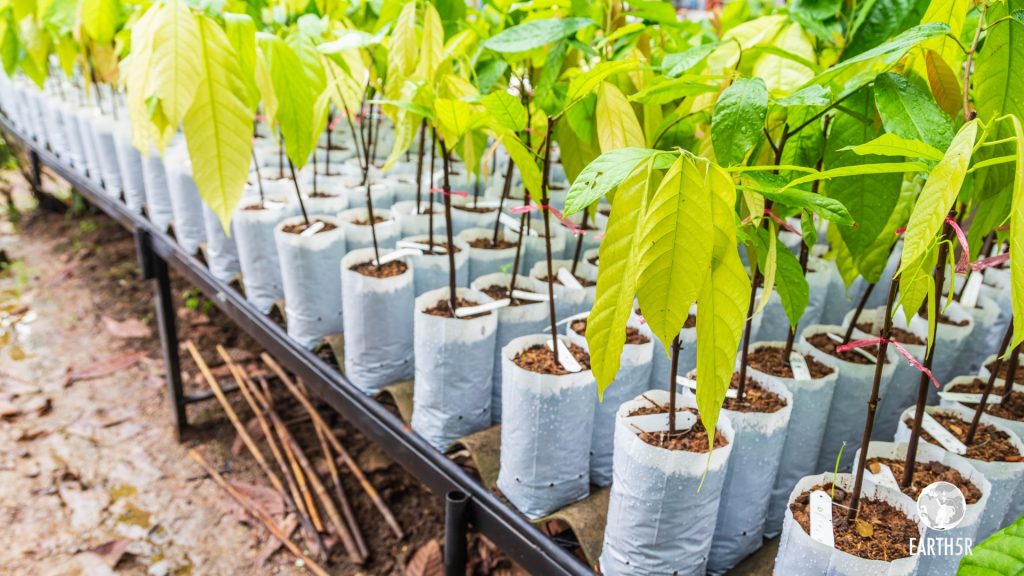Achieving sustainability, whether at the individual, community, or global level, involves making choices and taking actions that promote the well-being of the present generation without compromising the ability of future generations to meet their needs.
Achieving Sustainability: A Case Study on a Leading Global Aviation Brand’s Partnership with Earth5R
Introduction: The Journey to Achieving Environmental Sustainability in Aviation
In the aviation industry, achieving sustainability is a critical challenge due to the high levels of carbon emissions associated with air travel. As consumers become more environmentally conscious, aviation companies are under increasing pressure to adopt sustainable practices.
This white paper explores how a leading global aviation brand successfully partnered with Earth5R to offset its carbon footprint and enhance its brand image through genuine sustainability initiatives.
Company Background

As a prominent player in the global aviation industry, this leading brand operates a vast fleet of aircraft, serving millions of passengers worldwide. Recognizing the urgent need to address environmental concerns and meet consumer expectations, the company sought to integrate sustainability into its core business strategy.
The Challenge for Achieving Sustainability

The aviation brand faced several challenges in its journey toward achieving sustainability:
- High Carbon Footprint: Aviation is a significant contributor to global carbon emissions, and the brand needed to find effective ways to mitigate its impact.
- Consumer Trust: With rising skepticism about corporate greenwashing, the brand needed to establish itself as genuinely committed to achieving sustainability.
- Regulatory Pressure: New environmental regulations required the brand to adopt more sustainable practices and transparently report its environmental impact.
The Solution: Partnering with Earth5R for Achieving Sustainability
To address these challenges, the aviation brand partnered with Earth5R, a global sustainability organization renowned for its on-ground decarbonizing programs. This partnership allowed the brand to:
- Offset its carbon emissions by investing in Earth5R’s initiatives.
- Gain credibility and consumer trust by displaying the ‘Sustainability Partner – Earth5R’ logo.
- Comply with regulatory requirements through transparent reporting of its environmental impact.
Implementation for Achieving Sustainability
1. Carbon Footprint Assessment the first step for Achieving Sustainability

The brand began by conducting a comprehensive assessment of its carbon footprint, analyzing emissions from fuel consumption, ground operations, and supply chain activities. This assessment identified key areas where emissions were highest and highlighted opportunities for reduction.
2. Investing in Decarbonizing Programs a key step for Achieving Sustainability
Based on the assessment, the brand collaborated with Earth5R to invest in targeted decarbonizing programs. These included:
- Urban Plantation Projects: Planting trees in urban areas to sequester carbon dioxide and improve air quality.

Waste Management Initiatives: Supporting Earth5R’s comprehensive waste management programs aimed at reducing landfill waste and promoting recycling.

Plastics Recycling Programs: Investing in Earth5R’s initiatives to collect, recycle, and repurpose plastic waste, thereby reducing pollution and conserving resources.

3. Achieving Sustainability in Aviation: Lessons for Other Brands
To communicate its commitment to achieving sustainability, the brand prominently displayed the ‘Sustainability Partner – Earth5R’ logo on its marketing materials, shared stories in their in-flight magazine and digital platforms. The logo served as a visual testament to the company’s genuine efforts to reduce its environmental impact and align with consumer values.
4. Consumer Engagement
The brand launched a comprehensive consumer engagement campaign to educate passengers about its sustainability initiatives. This included:
- Transparent Reporting: Publishing detailed reports on the company’s environmental impact and progress toward achieving sustainability goals.
- Interactive Platforms: Creating online platforms where consumers could track the brand’s sustainability efforts and learn about the benefits of supporting eco-friendly aviation.
- Community Programs: Organizing events and workshops in collaboration with Earth5R to raise awareness and encourage collective action for environmental preservation.
Results
Environmental Impact
- Carbon Emissions Reduced: The brand successfully offset 23,700 metric tons of CO2 emissions through its partnership with Earth5R.
- Waste Reduction: Earth5R’s waste management initiatives helped divert 5,750 metric tons of waste from landfills.
- Plastic Recycling: The partnership enabled the recycling of 1,550 metric tons of plastic waste, reducing environmental pollution and conserving resources.
Business Benefits
- Enhanced Brand Image: The ‘Sustainability Partner – Earth5R’ logo helped the brand distinguish itself as a leader in sustainable aviation, attracting environmentally conscious passengers.
- Increased Consumer Trust: Transparent reporting and genuine sustainability efforts boosted consumer trust and loyalty.
- Regulatory Compliance: The brand met and exceeded regulatory requirements, positioning itself as a responsible corporate citizen.
Market Performance
- Passenger Growth: The brand experienced a 7.3% increase in passenger numbers on the given sector, driven by the growing demand for sustainable travel options.
- Customer Loyalty: The company saw a 15.4% rise in customer retention rates on the given sector, with many passengers citing the brand’s commitment to sustainability as a key factor in their choice.
- Brand Advocacy: Positive word-of-mouth enhanced the brand’s reputation, leading to increased brand advocacy and market presence.
Conclusion
The aviation brand’s partnership with Earth5R demonstrates how businesses can effectively integrate and achieving sustainability into their operations and branding. By investing in genuine environmental initiatives and transparently communicating their efforts, companies can not only reduce their carbon footprint but also enhance their brand image, gain consumer trust, and drive business growth.
For companies looking to embark on a similar journey, this case study provides a blueprint for success. Partner with reputable and achieving sustainability organizations like Earth5R, engage in impactful decarbonizing programs, and communicate your efforts transparently to achieve both environmental and business benefits.
About Earth5R
Earth5R is a global sustainability organization dedicated to creating the world’s largest community of citizens for environmental preservation. Through its app and on-ground initiatives, Earth5R empowers individuals and businesses to participate in sustainable practices and make a tangible impact on the planet.
For more information on how to become a Sustainability Partner with Earth5R, visit our website or contact us directly. Let’s make a lasting impact together.
What is a sustainable brand?
A sustainable brand is a brand whose mission brings sustainable environmental, human or social benefits to all its stakeholders: consumers, employees, suppliers and partners throughout its value chain and product life cycle;
“A sustainable brand integrates eco-friendly practices, benefiting society and sparking consumer interest in its products or services.
In 2021, consumers want to know what they are buying and are choosing transparent and ethical brands. It is up to industry to take this into account by taking concrete action to protect the environment. Climate change and social crises have turned our vision of the world and its limits on its head.
People have become aware of the impact of their consumption: 74% of Europeans say they have changed their consumption habits and 60% of French people think it is urgent to do something for the planet. So what action should be taken?
Consumers are changing their everyday behavior, practicing de-consumption or consom’action. They buy second-hand products, use applications to help them consume better, and make a point of choosing quality and eco-responsible products. Consumers choose to join forces to boycott a company and its practices… They do their own research and make a commitment to the environment by finding alternatives in the manufacture of ‘homemade’ cleaning and beauty products.
For 62% of them, it is up to companies to rally to the side of consumers to help them reduce the impact of their consumption. Companies could therefore regain the confidence of buyers if they took the right measures.
A sustainable, ethical or fair trade brand is therefore committed to sustainable development. It adopts virtuous, eco-friendly and socially responsible production practices. It proposes concrete environmental solutions or effective social solutions. Brands are sustainable when they choose to commit to a more resilient planet, to a more stable future, far from destructive climate change.
How can you recognize a sustainable brand?
It’s not always easy to recognize truly sustainable brands. Between 2004 and 2019, trust in brands fell by 30%, from 58% to 27%. This significant level of mistrust is partly explained by unacceptable health, social and environmental scandals.
When brands that claim to be “sustainable” are driven solely by marketing considerations that are devoid of meaning and, above all, action, they are practicing “greenwashing”. These companies adopt a deceptively virtuous approach to social and environmental issues, with the sole aim of making themselves more attractive to consumers.
To recognize a sustainable brand, you need to ask yourself a few questions and have a few reflexes:
Environmental or social claims for achieving sustainability :
A sustainable brand will naturally tend to highlight the efforts it is making to reduce its impact.
It is therefore important to pay attention to the different types of claims made by these brands.
For example, the words “recycled”, “ethical” and “ecological” should set off alarm bells. The sustainable brand implements a strategy to be identified as such. But at this stage, it’s not enough to prove that the brand is truly sustainable.
Labels or other official endorsements :
Environmental claims must be validated to confirm that they have been made. If a brand advertises fair trade, for example, it will normally display a label such as “Fairtrade”, together with the inspection body that issued it. And the same applies to many claims. Do not hesitate to check that the label displayed by the brand is not a pseudo-label that the brand has awarded itself.
Value for money:
Each product or product category has a fair price, allowing the product to be developed to quality standards that protect people and the planet. If you have a brand in front of you that deploys a wealth of sustainable communication but whose product is the cheapest on the market, it is unlikely that its communication will be followed up by action.
There are many different commitments that make a brand ethical and eco-responsible, and consumers have different ways of assessing a brand’s commitment to sustainable development. Everyone has different considerations when it comes to achieving sustainability. For some, the most important thing is that the product carries a label. Others are more interested in brands that take steps to reduce carbon emissions on the planet. Still others prefer companies that support non-profit associations and redistribute a share to concrete actions. It’s up to you to decide what’s really important to you and what you think will make sense for future generations.
Why choose a sustainable brand?
Choosing to buy from a sustainable brand has many advantages. First of all, you can be sure you’re buying quality products. Then you can be sure you’re buying a product that respects the environment and the workers behind it. So it’s great for your carbon footprint.
If the product is sturdier, made from solid, quality materials, then you’ll find personal benefits too. An eco-friendly product is not necessarily durable in the sense of “longevity”. On the other hand, the reverse is always true. A solid, long-lasting product that breaks with programmed obsolescence helps limit environmental impact, as it will be replaced less quickly and the resources extracted for its manufacture will be better optimized. You’ll also save money, as you’ll be able to keep the product for a very long time. What an advantage!
LONGTIME® products, for example, have a very long service life and are also highly repairable. This means that you can have the product repaired even several years after purchase, because it meets stringent reparability criteria (for example, spare parts must be available even after the product has been discontinued).
In a few words, buying from a sustainable brand means :
- Significant improvements to your budget and your health
- Preserving the environment and the local economy
- Pressure on major groups to respond to new consumer demands
- The gradual spread of responsible consumption
How do you know if a brand has a sustainable policy?
To find out whether a brand has a sustainable policy, visit the brand’s communication materials. In principle, if the brand is committed, it will do its utmost to make this known to its customers. If information is hard to find, there may be questions to ask about the brand’s policy.
To find a sustainable brand, you need to trust third parties: agencies, labels, social networks… You need to look for labels, certifications or information “validated by an independent and objective organization”, or third-party opinions on social media. To form your own opinion, you need to find out how the product is made, for example by researching specialist websites.
The role of the brand is also fundamental. Consumers look for environmental or health information directly on the packaging of the products they buy. They also look directly at a company’s sustainability practices to learn more about the values and principles of the brand they are buying, which means that brands need to communicate better about their commitments. Visit the brand’s website. Information can be found in the “About us” or “Our values” categories. These are categories that can easily be found on websites. There are also tabs dedicated to the environment. There is a need for brands to better tell the story of their sustainability policies, through a variety of communication channels, so that consumers can easily access the information they need.
You can also visit the brands’ boutiques and events to find out more about their commitments.
For example, an ethical fashion brand will offer clothes made from eco-responsible materials (organic…) and with ethical manufacturing processes.
What are the different types of sustainable brands?
Sustainable brands can be distinguished by the impacts they choose to reduce the most. The more holistically a brand takes into account and reduces its impacts, the more sustainable it is. They differentiate themselves by rethinking their offers and products to provide solutions to the social and environmental concerns of their customers and society at large. They are also generally transparent, and seek to explain who they are, the values they stand for and how they are involved and active. Their vocation is to inspire and drive change.
Sustainable branding and the environment :
A brand can distinguish itself by marketing products that respect the environment (ecosystem, flora and fauna).
Either because they don’t use phytosanitary products that are harmful to our ecosystems (agriculture, cosmetics, clothing) or because the materials they use are not harmful to the environment (equipment, clothing). Our brands also include companies that choose to reduce their carbon footprint (renewable energy, eco-designed packaging, deposits, rail transport, etc.). Fishing is another sector that could fall into this category.
Sustainable branding and fair trade:
Food and textile companies can be particularly vulnerable to social issues. Some raw materials (cocoa, coffee, cotton…) come from countries where labor laws and/or labor costs do not allow for the protection of workers and their fair remuneration. Fair trade labels help to alleviate these problems and assure consumers that production is socially responsible, thanks in particular to a pricing policy that takes the entire value chain into account.
Sustainable branding and extended product life:
Last but not least, some companies are developing policies to ensure the rational use of the earth’s resources by combating obsolescence and reducing premature waste. The LONGTIME® label is dedicated to this theme.
There is a range of additional actions to help companies move into the circular economy. Relocation, solidarity commitments by supporting non-profit associations and organizations involved in sustainable development, selection of environmentally-friendly suppliers, reconditioning… these are just a few examples.



